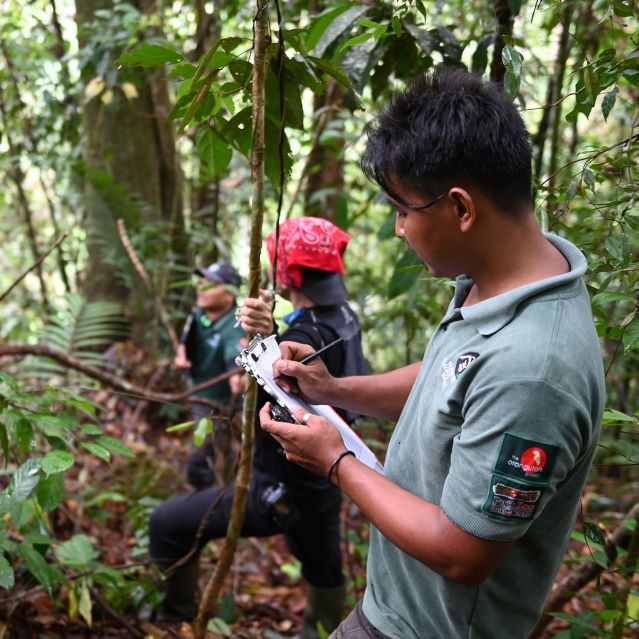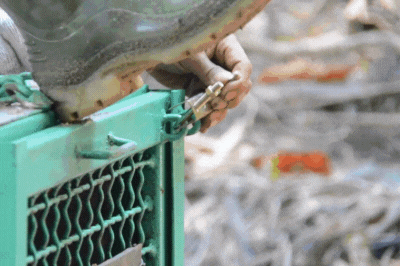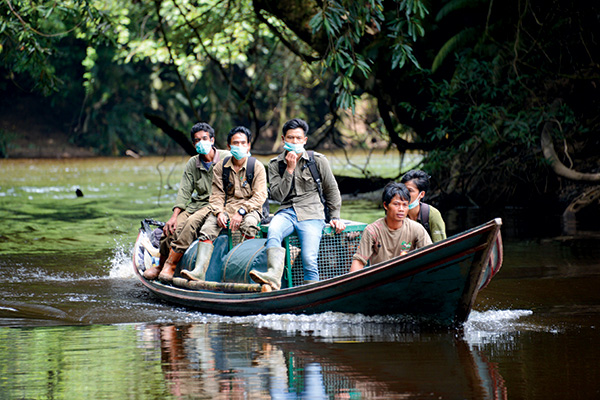Our supporters fund projects like the BOSF Post Release Monitoring project, which works to meticulously monitor Critically Endangered orangutans recently released into the wild.
The Unfinished Odyssey of Orangutans in the Wild
Borneo, the third-largest island in the world, has long been a sanctuary for some of Earth's most extraordinary creatures, the Critically Endangered orangutan. But in a world fraught with deforestation, illegal capture, and habitat destruction, their journey to survival is far from over.
Within the heart of this threatened landscape, the Borneo Orangutan Survival Foundation (BOSF) operates the world's two largest orangutan rescue centres.
All about BOSF
Located in Central Kalimantan, Borneo, Indonesia, the Borneo Orangutan Survival Foundation (BOSF) operates the world's two largest orangutan rescue centres.
These centres are a safe haven for orangutans displaced from their natural habitats or orphaned due to illegal capture. Many arrive as very young orangutans, requiring extensive rehabilitation to acquire the skills necessary for survival in the wild.
Their rehabilitation process is a testament to dedication and experience, adhering to national and international guidelines. Orangutans go through a comprehensive training program, preparing them for life in the wild. This process takes years, involving stages of 'Forest School' and survival skills, all with the guidance of surrogate mothers.
In 2012, BOSF launched a substantial reintroduction program, releasing southern Bornean orangutans into the Bukit Batikap Protection Forest. Over 175 orangutans have been successfully reintroduced here, and their post-release monitoring suggests they are thriving in their new environment.
Thanks to our dedicated donors, The Orangutan Project has been a long-standing supporter of the enrichment and welfare programs at these centres.
Post-release monitoring
The Post-Release Monitoring Program, supported for many years by the generous supporters of The Orangutan Project, plays a pivotal role in ensuring the success of BOSF’s reintroduction efforts.
This program involves extensive dawn-to-dusk observations and nest-to-nest monitoring of reintroduced orangutans, along with the collection of standardized behavioural and health data.
This invaluable data helps assess the effectiveness of the reintroduction process and enables the team to address any weaknesses in various stages, from rescue to rehabilitation, release, and post-release monitoring.
With a permanent presence in Batikap, the post-release monitoring team is well-equipped to intervene when necessary, providing essential food or veterinary care, or, as a last resort, returning orangutans to sanctuary care.
Their work is made possible by high-tech equipment, including satellite phones, handheld GPS units, and radio tracking equipment that picks up signals from small radio transmitters implanted under the skin of reintroduced orangutans.
The Orangutan Project's financial support for this program covers staff salaries, transport costs, and field equipment such as radio receivers and antennas.
This support is crucial for ensuring the well-being and survival of released orangutans and contributes to the ongoing success of orangutan conservation efforts.
Ensuring Successful Adaptation
Post-release monitoring is a pivotal process that begins after the release of orangutans into their natural habitat. It focuses on ensuring that these magnificent creatures are adjusting well to their new environment. Through regular observations, it helps determine how they are adapting to life in the wild.
Health and Well-being
Post-release monitoring plays a crucial role in monitoring the health and well-being of released orangutans. It is a safety net that ensures the ongoing survival and thriving of these incredible individuals. Daily health checks, nest surveys, and frequent observations help spot potential issues early.
Protecting the Forest
Beyond the orangutans themselves, post-release monitoring safeguards the forests they inhabit. The vigilant presence of monitoring teams helps deter illegal activities that might harm both the habitat and its inhabitants, ensuring that orangutans are not disturbed.
Mitigating Human-Orangutan Conflict
The post-release monitoring process actively works to mitigate human-orangutan conflict. This includes engaging with local communities, teaching them about orangutans, and fostering a harmonious coexistence. The goal is to reduce potential conflicts that might arise due to misunderstandings.
Community Involvement
Local stakeholders are key players in the conservation efforts. Community development teams regularly engage with people living near release sites, raising awareness and encouraging sustainable practices. Collaborative efforts help protect the forest and its orangutan residents.
Long-term Protection
The ultimate goal of post-release monitoring is to contribute to the long-term protection of release sites in partnership with local government authorities. This paves the way for the ongoing survival of orangutans and the preservation of their habitat.
Your impact
Your support for The Orangutan Project empowers organizations like BOSF to reintroduce orangutans back into their natural, safe habitats.
The generosity of our donors provides funding for critical activities such as post-release monitoring.
As orangutans venture back into the wild, this monitoring ensures their well-being, allowing for timely interventions if needed.
Your donations fund field staff, equipment, and technology, like radio tracking, which is vital for tracking these released orangutans.
Donate Now to Support Post-Release Monitoring of Critically Endangered Bornean Orangutans




.jpg)